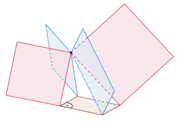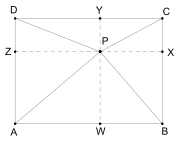British flag theorem
In Euclidean geometry, the British flag theorem says that if a point P is chosen inside rectangle ABCD then the sum of the squares of the Euclidean distances from P to two opposite corners of the rectangle equals the sum to the other two opposite corners.[1][2][3] As an equation:


The theorem also applies to points outside the rectangle, and more generally to the distances from a point in Euclidean space to the corners of a rectangle embedded into the space.[4] Even more generally, if the sums of squares of distances from a point P to the two pairs of opposite corners of a parallelogram are compared, the two sums will not in general be equal, but the difference of the two sums will depend only on the shape of the parallelogram and not on the choice of P.[5]
The theorem can also be thought of as a generalisation of the Pythagorean theorem. Placing the point P on any of the four vertices of the rectangle yields the square of the diagonal of the rectangle being equal to the sum of the squares of the width and length of the rectangle, which is the Pythagorean theorem.
Proof

Drop perpendicular lines from the point P to the sides of the rectangle, meeting sides AB, BC, CD, and AD at points W, X, Y and Z respectively, as shown in the figure; these four points WXYZ form the vertices of an orthodiagonal quadrilateral. By applying the Pythagorean theorem to the right triangle AWP, and observing that WP = AZ, it follows that
and by a similar argument the squares of the lengths of the distances from P to the other three corners can be calculated as
- and
Therefore:
Naming

This theorem takes its name from the fact that, when the line segments from P to the corners of the rectangle are drawn, together with the perpendicular lines used in the proof, the completed figure somewhat resembles a Union Flag.
References
- Lardner, Dionysius (1848), The First Six Books of the Elements of Euclid, H.G. Bohn, p. 87. Lardner includes this theorem in what he calls "the most useful and remarkable theorems which may be inferred" from the results in Book II of Euclid's Elements.
- Young, John Wesley; Morgan, Frank Millett (1917), Elementary Mathematical Analysis, The Macmillan company, p. 304.
- Bôcher, Maxime (1915), Plane Analytic Geometry: with introductory chapters on the differential calculus, H. Holt and Company, p. 17.
- Harvard-MIT Mathematics Tournament solutions, Problem 28.
- Hadamard, Jacques (2008), Lessons in Geometry: Plane geometry, American Mathematical Society, p. 136, ISBN 978-0-8218-4367-3.
Further reading
- Nguyen Minh Ha, Dao Thanh Oai: An interesting application of the British flag theorem. Global Journal of Advanced Research on Classical and Modern Geometries, Volume 4 (2015), issue 1, pp. 31–34.
- Martin Gardner, Dana Richards (ed.): The Colossal Book of Short Puzzles and Problems. W. W. Norton, 2006, ISBN 978-0-393-06114-7, pp. 147, 159 (problem 6.16)
External links
| Wikimedia Commons has media related to British flag theorem. |
- British Flag Theorem at artofproblemsolving.com
- Can You Solve Microsoft's Rectangle Corners Interview Question? (video, 5:41 mins)